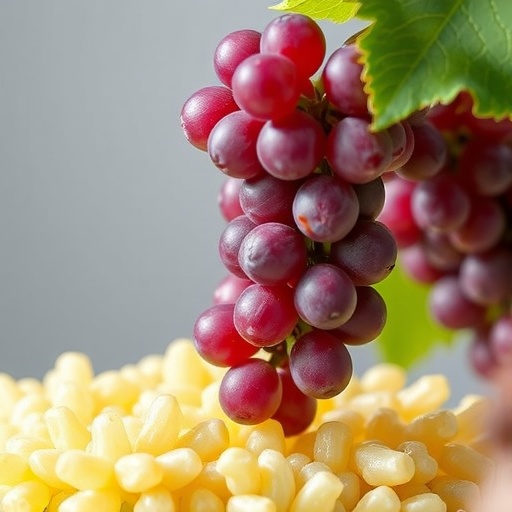In a groundbreaking study, researchers have unveiled a sustainable approach to produce high-value bioplastics from an unexpected source: white grape pomace. This pomace, which is often dismissed as agricultural waste, is being repurposed by scientists who see great potential in its biochemical makeup. As the world grapples with the challenges of plastic pollution, this innovative research offers a glimpse into a more sustainable future, demonstrating how organic waste can be transformed into functional materials.
Grapes are widely enjoyed for their various applications, from table consumption to fermentation for wine. However, the byproducts of grape processing, particularly the pomace, which includes skins, seeds, and stems, are typically discarded or used for less valuable applications such as animal feed. This research aims to change that narrative by illustrating how white grape pomace can be exploited for biopolymer production, specifically polyhydroxybutyrate (PHB).
Polyhydroxybutyrate is a type of biopolymer that has garnered attention for its biodegradability and potential to replace conventional plastics. As environmental concerns grow, the demand for bioplastics is on the rise. The process of converting white grape pomace into PHB not only helps in addressing the plastic waste crisis but also offers a viable solution for utilizing agricultural waste effectively, thus contributing to a circular economy.
The research is anchored by a specific strain of bacteria, Bacillus sp. MUN4, which plays a pivotal role in the biosynthesis of PHB from the grape pomace. This bacterial strain is known for its robust metabolic processes, which can efficiently convert the sugars and other organic materials present in grape pomace into PHB granules. Bacillus species are commonly found in various environments and are recognized for their versatility, making them excellent candidates in biotechnological applications.
One of the significant advantages of using white grape pomace is its rich carbohydrate content, primarily in the form of sugars like glucose and fructose. These sugars are readily available during the bacterial fermentation process. By harnessing the natural fermentation abilities of Bacillus sp. MUN4, researchers can effectively convert these sugars into PHB, offering a method that is both economically and environmentally beneficial. The efficiency of this conversion process is critical for large-scale applications, which researchers are optimistic about achieving.
Another noteworthy aspect of this study is the focus on optimizing the fermentation conditions to maximize PHB production. Factors such as pH, temperature, and fermentation time are crucial for ensuring that Bacillus sp. MUN4 performs at its best. Through a series of experiments, the research team is meticulously adjusting these variables to find the sweet spot where PHB production is maximized while maintaining the health of the bacterial culture.
The environmental implications of this research are profound. By shifting the focus from fossil fuel-derived plastics to bioplastics sourced from agricultural waste, the study contributes to a significant reduction in greenhouse gas emissions associated with plastic production. Additionally, the biodegradability of PHB means that once its lifecycle is complete, it can decompose naturally, mitigating the long-term impacts of plastic waste on landfills and ecosystems.
Furthermore, the valorization of white grape pomace in this manner highlights the importance of innovation in agricultural waste management. With millions of tons of grape pomace produced annually, the potential scalability of this process represents a promising avenue for both reducing waste and creating sustainable materials. This can be particularly beneficial for wineries and grape growers looking to minimize their ecological footprint while adding value to their products.
In terms of economic viability, utilizing agricultural waste for high-value products such as PHB presents appealing opportunities for farmers and businesses alike. By creating a market for bioplastics derived from grape pomace, there is potential for job creation and economic stimulation in rural areas. This model can encourage a shift in agricultural practices toward sustainable methods, promoting a more responsible approach to food production and waste management.
The study emphasizes not just the science behind the conversion of grape pomace into PHB, but also the broader implications for sustainability and environmental stewardship. As more researchers explore similar pathways of biomaterials production, the hope is to create a ripple effect that inspires industries to seek greener alternatives to their traditional practices.
In conclusion, the valorization of white grape pomace for polyhydroxybutyrate production by Bacillus sp. MUN4 represents a remarkable endeavor at the intersection of biotechnology and environmental science. This research illustrates the potential for waste materials to contribute meaningfully to sustainable development, paving the way for a future where bioplastics can coexist alongside their petroleum-based counterparts. The outcome of this study could reshape not only how we think about waste but also how we envision a more sustainable relationship with our agricultural practices.
As we advance, further studies and developments in this arena could refine these processes and enhance our understanding of bacterial fermentation. The key to transforming our approach to waste and plastics lies in innovation, research, and a commitment to sustainability. With the insights gained from this study, the journey towards a greener, more sustainable future seems increasingly plausible.
By redirecting attention to under-utilized agricultural waste, researchers are not only addressing the pressing issue of plastic pollution but also championing a new paradigm of waste management that aligns with the principles of a circular economy. The future is ripe for exploration in this field, and the potential remains limitless.
Subject of Research: Valorization of White Grape Pomace for Polyhydroxybutyrate Production
Article Title: Valorization of White Grape Pomace for Polyhydroxybutyrate Production by Bacillus sp. MUN4
Article References:
Amiri Kojuri, S., Ahmady-Asbchin, S. Valorization of White Grape Pomace for Polyhydroxybutyrate Production by Bacillus sp. MUN4. Waste Biomass Valor (2025). https://doi.org/10.1007/s12649-025-03271-7
Image Credits: AI Generated
DOI:
Keywords: PHB, Bacillus sp. MUN4, White Grape Pomace, Sustainable Bioplastics, Agricultural Waste Valorization
Tags: Bacillus in biopolymer synthesisbiodegradable alternatives to plasticsbioplastics from agricultural wastechallenges of plastic pollutionenvironmental benefits of bioplasticsgrape processing byproductsinnovative waste repurposing techniquespolyhydroxybutyrate applicationsreducing plastic waste through bioplasticssustainable approaches in agriculturesustainable biopolymer productiontransforming grape pomace into materials





